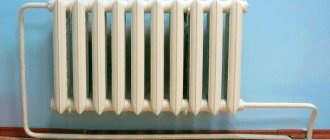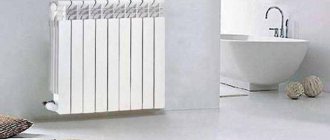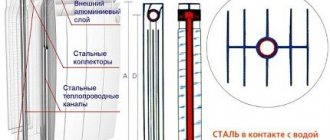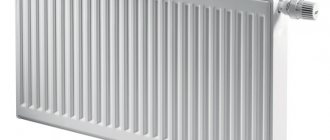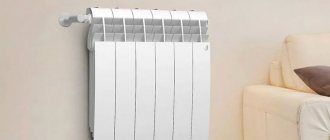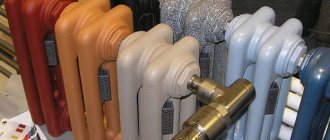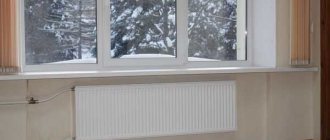Like any other device, aluminum radiators have their pros and cons. They differ from their analogues in high heat transfer, low weight and attractive appearance. However, their Achilles heel is corrosion. You should carefully choose the manufacturer and device so that it will serve you long enough.
First, let's figure out what aluminum radiators are. Today there are three types of aluminum radiators: extruded, cast and anodized. The first type is extruded in an extruder at high pressure and pressed with the remaining parts. The second type is made using injection molding technology. An alloy of aluminum and silicon is used for production. The third type is the most expensive and is made from highly purified aluminum with anodic oxidation of the entire surface. All of the above devices are capable of responding to changes in coolant temperature in a short period of time. However, these are not all the features. KP has compiled a rating of the top 10 best aluminum heating radiators.
Advantages of aluminum radiators
- Lungs. Convenient to transport.
- Installation is easy. Almost anyone can handle this task.
- Their heat output is high. They heat the room well and quickly.
- The price of aluminum heating radiators is reasonable.
- They have a beautiful appearance.
- You can clean them yourself. Dust does not form between sections as often.
- Their coating is heat-resistant. No need to paint. This is especially pleasing to those who are used to constantly painting radiators in old houses.
- Sections can be reduced or added.
- You can adjust the temperature on the batteries. Provided there are thermostats.
- Heats up quickly and cools down quickly. In a short amount of time you can warm up the room.
- Not subject to corrosion. If used in rooms with independent heating, they will serve their owners for a long time.
- You can repair it yourself. For example, if some kind of problem appears, these radiators can be removed, soldered and re-hung in place.
Prices: summary table
| Model | Heat transfer per section, Vit | Working pressure, atm | Breaking pressure, atm | Average price per section | Price for 1,000 W of power |
| Royal Thermo Biliner Alum 500 | 175 | 16 | 48 | 760 | 4 300 |
| Royal Thermo Revolution 500 | 170 | 20 | 50 | 850 | 5 000 |
| Global VOX R 500 | Up to 276 | 16 | 48 | 720 | 5 000 |
| Rifar Alum 500 | 186 | 15 | 50 | 750 | 4 000 |
| Radena 500 | 195 | 15 | 40 | 960 | 4 900 |
| ROMMER Al Optima 500 | 133 | 12 | 24 | 388 | 3 000 |
| Mandarino 500 | 210 | 15 | 25 | 1600 | 7 000 |
When choosing aluminum radiators, we primarily focus on technical characteristics and operating conditions. The right choice will allow you to avoid troubles in the form of structural destruction and flooding of premises, which can result in high repair costs.
Cons of aluminum radiators
- If you install them in rooms with central heating, then gases begin to accumulate in the upper part of such radiators. This leads to increased pressure. To prevent this, it is impossible to close the two taps that are located at the entrance to the batteries. Even if you close one tap, the radiator stops heating.
- Aluminum radiators are sometimes noisy when installed in houses with central heating. This will not happen if these radiators are installed by a professional and not a self-taught person.
- The strength of the material is low. They are easily damaged by mechanical stress. Therefore, they should only be transported in a box.
With a strong surge in pressure, it happens that they are damaged. Therefore, you need to choose batteries that have a reserve of operating pressure.
Main characteristics of aluminum radiators
- There may be different distances between the radiator axes. Before purchasing, you need to measure how many centimeters of free space there is under the window sill.
- The coolant temperature can be no more than 110 degrees.
- Radiators differ in operating and pressure testing. Basically, the working pressure is within 15 atm. Crimping pressure can reach 30 atmospheres. In the store you should pay attention to radiators that have some reserve in pressure. Because they will last longer and will not break.
- The service life is generally about twenty years. In order for batteries to last their life, you need to take care of them. Radiators should not be left without water for a long time. Rust may form.
- The warranty period for batteries is usually about five years.
- Beautiful appearance. You can install it not only in residential premises, but also in restaurants, cinemas, museums and so on.
- More suitable for private houses with autonomous heating.
Cast iron
Of course, what is new and prestigious is not always the best and highest quality. For this reason, the familiar accordion-style cast iron radiators, which were previously installed everywhere, still seem to many to be the best option for use in heating systems. Such radiators have their own advantages, expressed in resistance to corrosion, low price, standard section sizes, and the absence of the need to rework the pipework for them. For mansions with an autonomous heating system, this option is not ideal, because cast iron has higher thermal inertia. In addition, cast iron radiators are heavy. One of the main disadvantages of such radiators is the same dull design, which is why, as a rule, such radiators are often hidden behind various panels and screens.
Types of aluminum radiators
There are currently three types of aluminum radiators sold in stores. Each type has its own pros and cons. Next, let's take a closer look at what aluminum heating radiators there are.
Cast aluminum radiators
They are produced under pressure. An alloy of silicon and aluminum is used in their production. Such batteries are successful in Russia.
Extruded Aluminum Batteries
Such batteries are worse to use than cast batteries. They break more and can start leaking out of nowhere. They differ from cast ones in that there are seams on the radiator fins. It happens that they glue the sections together to connect them together.
Anodized aluminum batteries
This is the most expensive type of aluminum radiators. They are made from refined aluminum. Due to the fact that they are treated with anodic oxidation, they are more reliable. Less susceptible to corrosion.
Tips for choosing radiators
- It is better to buy batteries from well-known brands.
- The more expensive the cost, the better the quality.
- You need to study the passport of radiators before purchasing. All important characteristics are listed only there. Sometimes sellers are not well informed about the products.
- The heavier the radiators, the better. The back wall of the radiators should be thick. If the thickness is insufficient, then during pressure surges the heating device can easily break. The photo of aluminum heating radiators shows how thick the back wall and side ribs should be.
- It would be great if there was an oxide film on the radiators.
Steel
Steel radiators are most common in country houses. Their main advantages are low thermal inertia and good thermal conductivity. At the same time, they have low resistance to hydraulic shocks. Steel radiators can be not only sectional, but also made in the form of panels. Panel structures are made of two sheets, between which channels are formed for coolant circulation. As a rule, steel radiators are inexpensive and have greater thermal conductivity than cast iron radiators, but less than duralumin radiators. Weld seams in steel panel radiators are their weak link, since under the influence of high pressure or hydraulic shock, leaks can form in them. In addition, in such radiators the cross-section of the channels is smaller compared to sectional type batteries, which can cause them to quickly clog. Steel sectional radiators have thicker walls and larger channel diameters.
Popular brands of radiators
- Rommer. One of the high-quality radiator models made in China. Their heat output level is 175 watts. The dimensions of aluminum heating radiators are very compact. The warranty period is five years. They can be connected from below and from above. There is an oxide film inside the radiators.
- Royal. This type of radiator is produced in Russia. They are made from an alloy that includes silicon and titanium additives. Thanks to this, they are less susceptible to corrosion and more durable. Their operating pressure is 20 atmospheres. The radiator fins have such a structure that heat transfer increases.
- Rifar. Manufactured in Russia. In the production process, Italian technologies from the Global organization are used. Such radiators can withstand high pressure. They are very easy to wash. Many consumers believe that these are the best aluminum radiators on the market. No one notices any leaks because there are special O-rings. They don't let it leak. The radiators are coated on all sides with anodic electrodeposition. Thanks to this, buyers notice that they are less susceptible to damage.
- Global Vox. These are Italian-made radiators. Their service life is about 10 years. Reviews about aluminum heating radiators are mostly positive. Their big advantage is that they can be placed in systems where pipes are made of various materials. Such radiators can withstand pressure up to sixteen atmospheres. They heat up in minutes and cool down just as quickly. These heating devices will suit any apartment or house design. Hanging will not be difficult.
Even the inexperienced can cope. Customers who did not install air vents complained that they did not last long. So, the installation of air vents is considered mandatory when choosing these radiators. This air vent is needed to remove gases inside the radiators.
How to choose the right one
The question of choice is always of interest to consumers, especially when it comes to tall units. First of all, you need to take into account the height of the ceilings, since it can be 2.5 meters, and the products have a size of up to 3 meters. The main thing here is not to make a mistake, otherwise the product simply won’t fit.
For apartments and children's rooms it is better to take tubular models. They best meet the requirements and are safer.
Tubular radiators have a number of advantages:
- withstand pressure up to 10 atmospheres;
- connected by laser welding;
- smoothed corners prevent injury;
- uniform heating of the room;
- convenient cleaning.
The second point is the amount of heat required for a comfortable microclimate in the room. And in this regard, tubular models are convenient, since they can have from 1 to 6 rows in depth. If the unit will be mounted in a wall, you must first measure its width.
For private houses, the type of radiator is not of fundamental importance, since the pressure in the autonomous system is low and there is no risk of ruptures. Cast iron, aluminum, bimetallic, and steel models are suitable here. The main thing is that they fit harmoniously into the interior and evenly warm the room.
